History and Heritage of Pradelles |
Pradelles derives its historical significance from its strategic location at the crossroads of major trade routes and as a border between Languedoc and Velay. Its past is marked by the Wars of Religion, and it was a coveted stronghold. In the Middle Ages, the town developed around its Church of Saint-Jean-Baptiste, built on a rocky promontory overlooking the Allier valley. The village preserves many testimonies from this period, particularly through its cobblestone streets and houses made of volcanic stone. Its classification as one of the "Most Beautiful Villages in France" highlights the richness of its preserved architectural heritage. The ancient Via Régordane, a historical and commercial route, contributed to its past prosperity. Finally, Pradelles is also famous for its Museum of Draft Horses, which reflects the importance of animal traction in the rural history of the region.
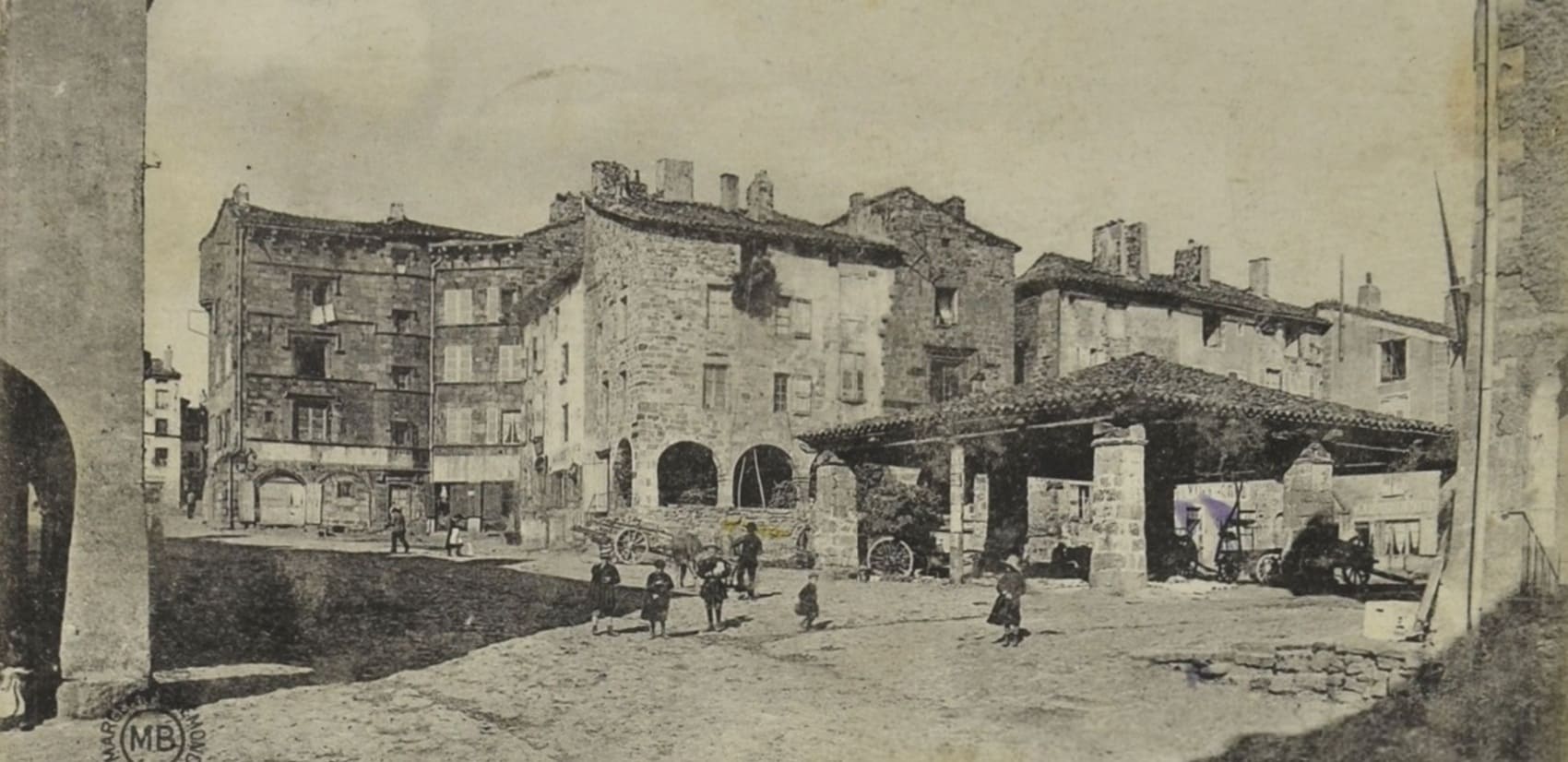
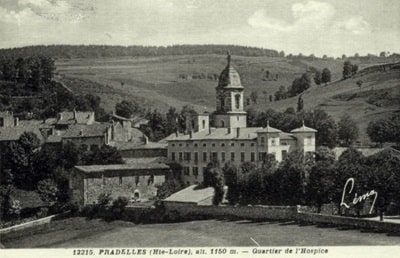 Pradelles is a village that has withstood the test of time, nestled between the mountains of Velay, Vivarais, and Gévaudan. Its name comes from the Latin "Pratellas," meaning "small meadows." In one of these meadows, a statue of the Virgin Mary was discovered in 1512, which would change the village's fate. This statue, buried in the ground, was revealed by a farmer's spade. It was made of wood, painted blue and white, and held the Child Jesus in its left arm. It was immediately placed in a chapel, built right at the spot of its discovery. But this was not the first time Pradelles welcomed the Virgin. Indeed, the village already existed in the 11th century and had a church dedicated to Saint Hilary of Lespéron, which had been given to the Abbey of Gellone by the lord of Pratellas. This church was located near a fortress that overlooked the Allier valley.
Pradelles is a village that has withstood the test of time, nestled between the mountains of Velay, Vivarais, and Gévaudan. Its name comes from the Latin "Pratellas," meaning "small meadows." In one of these meadows, a statue of the Virgin Mary was discovered in 1512, which would change the village's fate. This statue, buried in the ground, was revealed by a farmer's spade. It was made of wood, painted blue and white, and held the Child Jesus in its left arm. It was immediately placed in a chapel, built right at the spot of its discovery. But this was not the first time Pradelles welcomed the Virgin. Indeed, the village already existed in the 11th century and had a church dedicated to Saint Hilary of Lespéron, which had been given to the Abbey of Gellone by the lord of Pratellas. This church was located near a fortress that overlooked the Allier valley.
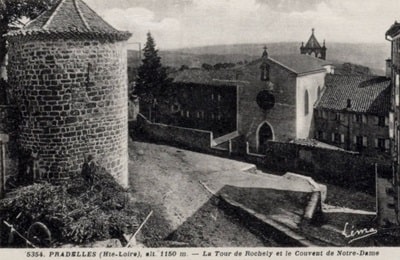 At that time, Pradelles was a fortified place situated on the Régordane route, a commercial and religious road that connected Auvergne to Languedoc. The village hosted merchants transporting products from the South, such as wine, salt, or silk, as well as pilgrims heading to Saint-Gilles, a sanctuary dedicated to a 7th-century hermit. To accommodate them, Pradelles had a hospital located outside the walls to mitigate the risks of contagion or attack.
At that time, Pradelles was a fortified place situated on the Régordane route, a commercial and religious road that connected Auvergne to Languedoc. The village hosted merchants transporting products from the South, such as wine, salt, or silk, as well as pilgrims heading to Saint-Gilles, a sanctuary dedicated to a 7th-century hermit. To accommodate them, Pradelles had a hospital located outside the walls to mitigate the risks of contagion or attack.
Pradelles then faced difficult times during the religious wars between Catholics and Protestants in the 16th century.
Antoine de La Tour Saint-Vidal was a French noble and military man who lived in the 16th century. He was the baron of Saint-Vidal, the seneschal of France, and the grand master of the artillery of France for the Catholic League. He was also the governor of Velay and Gévaudan, two provinces in southern France. As governor, he defended Velay against attacks from the Protestants led by François de Coligny during the religious wars. In December 1585, he repelled an attempt by Coligny to seize Le Puy, the capital of Velay, after Coligny had just ransomed the town of Pradelles, located in Velay. He did the same in 1587, forcing Coligny to retreat after paying him a sum of money.
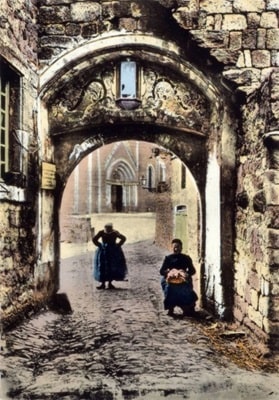 Antoine de La Tour Saint-Vidal was a cultured man who brought Italian art and the Renaissance into his castle at Saint-Vidal. There, he had a suite built in his name, decorated with a period fireplace and a sculpted French ceiling. He died in 1591, leaving behind a reputation as a keen strategist and fervent Catholic. The following year, a fire destroyed part of the village but spared the chapel of Our Lady. The inhabitants saw this as a miracle and began to pray to the Virgin with more fervor. Their faith was rewarded on March 10, 1588, when the Protestants returned to pillage Pradelles. The Catholics, armed with forks, sickles, and sticks, courageously resisted and drove them away. They attributed this victory to the intercession of Our Lady, who had protected them from the top of her bell tower.
Antoine de La Tour Saint-Vidal was a cultured man who brought Italian art and the Renaissance into his castle at Saint-Vidal. There, he had a suite built in his name, decorated with a period fireplace and a sculpted French ceiling. He died in 1591, leaving behind a reputation as a keen strategist and fervent Catholic. The following year, a fire destroyed part of the village but spared the chapel of Our Lady. The inhabitants saw this as a miracle and began to pray to the Virgin with more fervor. Their faith was rewarded on March 10, 1588, when the Protestants returned to pillage Pradelles. The Catholics, armed with forks, sickles, and sticks, courageously resisted and drove them away. They attributed this victory to the intercession of Our Lady, who had protected them from the top of her bell tower.
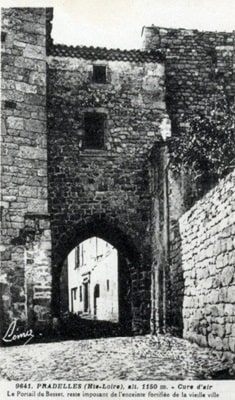 From that day forward, the cult of Our Lady of Pradelles spread throughout the region. The Dominicans, who settled in Pradelles in 1608, contributed to spreading awareness of the sanctuary. Many pilgrims came from afar to venerate the statue, especially on August 15, the day of the Assumption, when a procession would travel through the streets of the town. Among the miracles attributed to Our Lady of Pradelles is the healing of Marie Rivier, who would become the founder of the Sisters of the Presentation of Mary. Born on December 19, 1768, in Montpezat-sous-Bauzon, in Ardèche.
From that day forward, the cult of Our Lady of Pradelles spread throughout the region. The Dominicans, who settled in Pradelles in 1608, contributed to spreading awareness of the sanctuary. Many pilgrims came from afar to venerate the statue, especially on August 15, the day of the Assumption, when a procession would travel through the streets of the town. Among the miracles attributed to Our Lady of Pradelles is the healing of Marie Rivier, who would become the founder of the Sisters of the Presentation of Mary. Born on December 19, 1768, in Montpezat-sous-Bauzon, in Ardèche.
At the age of two, she fell and became paralyzed in her legs. She was miraculously healed at the age of six after praying to Our Lady of Pity. She then vowed to dedicate her life to God and the education of children. She went to study in Pradelles, where she felt called to become a nun. However, her fragile health prevented her from joining the Our Lady of Pradelles congregation. She then decided to open her own school in Montpezat-sous-Bauzon at the age of 18. She devoted herself to teaching and catechesis for the youth, especially the poorest.
In 1796, during the French Revolution, she founded the Congregation of the Sisters of the Presentation of Mary with four companions, placing it under the protection of the Virgin Mary. She aimed to train apostolic women capable of spreading the Gospel wherever they were sent. She opened numerous houses in France and even in Canada. She died on February 3, 1838, in Bourg-Saint-Andéol, where her congregation's mother house is located. She was beatified in 1982 and canonized in 2022 by Pope John Paul II. Her feast day is celebrated on February 3. She is regarded as a saint who successfully combined prayer and action, contemplation and mission, love of God and love of neighbor.
The statue of Our Lady of Pradelles also faced trials. In 1793, during the French Revolution, it was thrown into the fire by revolutionaries. Fortunately, it was saved in time, but it was damaged. It was restored with local wood and returned to its place in the chapel in 1802. In 1869, it was solemnly crowned in the presence of many faithful.
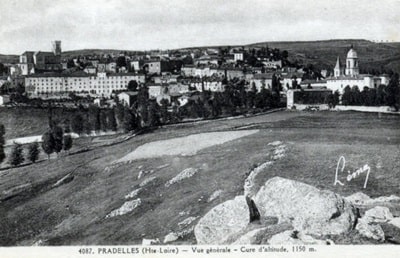 In 1790, when France was divided into departments, Pradelles, which belonged to Lower Vivarais, was attached to the department of Velay, which later became Haute-Loire. The inhabitants of Pradelles did not accept this and demanded to remain in Vivarais, their land of origin. They even sent two delegates to Paris to plead their case before the National Assembly. But their efforts were in vain, and Pradelles remained in Haute-Loire.
In 1790, when France was divided into departments, Pradelles, which belonged to Lower Vivarais, was attached to the department of Velay, which later became Haute-Loire. The inhabitants of Pradelles did not accept this and demanded to remain in Vivarais, their land of origin. They even sent two delegates to Paris to plead their case before the National Assembly. But their efforts were in vain, and Pradelles remained in Haute-Loire.
In 1832, Pradelles expanded by merging with the neighboring commune of Saint-Clément-de-Pradelles, which had been named Robertin during the Revolution. This name comes from an old medieval estate, the "mas des Robertins," located near the Allier, of which only the "bois des Robertins" remains today.
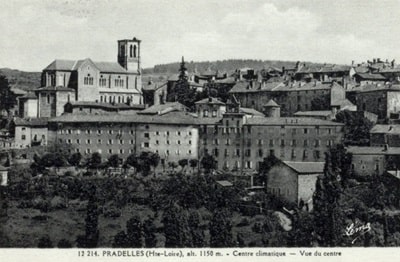 But Pradelles also hides a mystery beneath its cobblestones: a network of tunnels that extends under the village. These tunnels were dug by the inhabitants starting in the Middle Ages to protect themselves from enemy attacks. In times of danger, they could escape the village unseen and reach safe places outside the historical enclosure. These tunnels also served to store provisions, weapons, or valuable items. They are closed to the public due to safety concerns; most are collapsed, and the entrances are blocked for security reasons. Only a few private owners still have access to these secret passages, which bear witness to Pradelles' past.
But Pradelles also hides a mystery beneath its cobblestones: a network of tunnels that extends under the village. These tunnels were dug by the inhabitants starting in the Middle Ages to protect themselves from enemy attacks. In times of danger, they could escape the village unseen and reach safe places outside the historical enclosure. These tunnels also served to store provisions, weapons, or valuable items. They are closed to the public due to safety concerns; most are collapsed, and the entrances are blocked for security reasons. Only a few private owners still have access to these secret passages, which bear witness to Pradelles' past.
Today, Pradelles is a peaceful and charming village that has preserved its medieval heritage. One can admire its stone houses, winding streets, the Rochely tower, the Halle square, its Besset and Verdette gates, and the chapels of the penitents and Our Lady. Visitors can also enjoy the breathtaking view of the Haut-Allier valley, Mont Lozère, and Margeride, where the terrifying beast of Gévaudan roamed in the 17th century. Pradelles is a balcony of the south, where the sun shines and nature is generous.
Pradelles stands at the crossroads of medieval roots and the Renaissance era. The construction of houses with local stone and the arrangement of the streets respond to the climatic characteristics of the region, with harsh winters and abundant snow, and high temperatures in the summer.
***
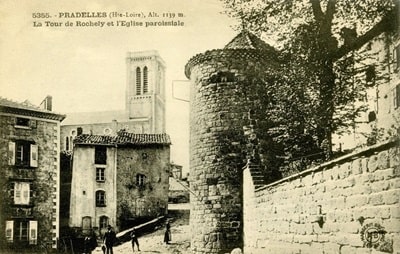 In the beating heart of the town stands the Verdette Gate, a silent guardian of history. Its precisely carved round arch tells tales of centuries of secret passages. The stone corbels, proudly perched at its summit, still whisper the legends of the vanished machicolations. Inside, the steps of an ancient staircase wind their way to the ramparts, inviting the curious to tread the paths of the guardians of old. And there, in a hidden niche, a Virgin with Child watches, eternal and gentle, over the souls passing through the archway.
In the beating heart of the town stands the Verdette Gate, a silent guardian of history. Its precisely carved round arch tells tales of centuries of secret passages. The stone corbels, proudly perched at its summit, still whisper the legends of the vanished machicolations. Inside, the steps of an ancient staircase wind their way to the ramparts, inviting the curious to tread the paths of the guardians of old. And there, in a hidden niche, a Virgin with Child watches, eternal and gentle, over the souls passing through the archway.
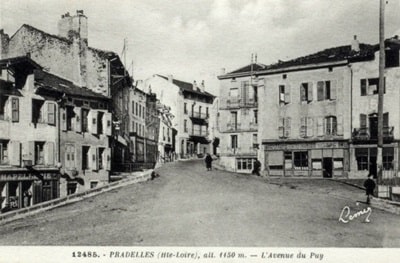 A Echo from the Past Once, the Saint-Clément church rose majestically under the benevolent gaze of the archpriest of Sablières. Its walls resonated with songs and prayers, a vibrant echo from the 11th and 12th centuries. But time, that relentless sculptor, has reduced its glory to dust. The sacred stones, silent witnesses of past fervor, have found a second life in the building of Pradelles. Near the way of Compostela, the ruins of the Saint-Clément chapel stand, remnants of a forgotten priory enclosure, where the ground retains the imprint of a semi-circular apse.
A Echo from the Past Once, the Saint-Clément church rose majestically under the benevolent gaze of the archpriest of Sablières. Its walls resonated with songs and prayers, a vibrant echo from the 11th and 12th centuries. But time, that relentless sculptor, has reduced its glory to dust. The sacred stones, silent witnesses of past fervor, have found a second life in the building of Pradelles. Near the way of Compostela, the ruins of the Saint-Clément chapel stand, remnants of a forgotten priory enclosure, where the ground retains the imprint of a semi-circular apse.
The ossuary, vaulted with ancient arches, hides within it a deep pit, guardian of buried secrets. Two stone sarcophagi, nestled beneath a broken vault, watch over the entrance, while the Sainte-Reine fountain whispers to the scattered sarcophagi. Below, the foundations of an enigmatic building hint at the history of a possible priory-curate. But alas, the greed of men, armed with dynamite, has shaken these walls rich in history, leaving behind the silence of lost centuries.
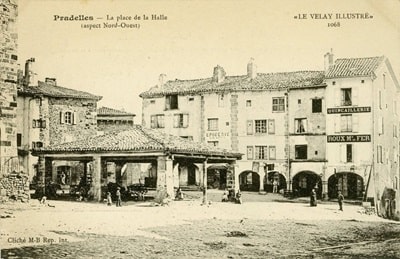 The Chapel of the Penitents of Pradelles is a silent witness to a centuries-old tradition. Born in 13th century Italy, the penitential fervor crossed the Alps to flourish in France from the 15th century. It was after 1550 that these devotional brotherhoods flourished, particularly in southern France.
The Chapel of the Penitents of Pradelles is a silent witness to a centuries-old tradition. Born in 13th century Italy, the penitential fervor crossed the Alps to flourish in France from the 15th century. It was after 1550 that these devotional brotherhoods flourished, particularly in southern France.
Haute-Loire saw the birth of its first brotherhood in Puy in 1584, a spiritual beacon that shone throughout the 17th century. In Pradelles, the penitents dressed in white, symbols of purity and renewal, gathered under the banner of the Gonfalon or the Holy Sacrament. The brotherhood of Pradelles, from its origins, possessed its own chapel—a rare privilege, a sign of its importance. But in 1680, fire consumed the original building. With faith and determination, the community of priests raised the ashes to erect a new chapel, inaugurated in 1696. In January 1790, this chapel became the epicenter of the nascent democracy, welcoming voters for the formation of Pradelles' first revolutionary municipality.
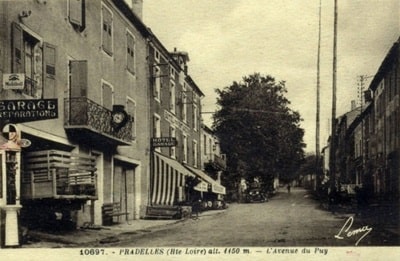 But the whims of history transformed it, and it was sold as national property in 1796. The chapel underwent a metamorphosis, becoming a barn, losing part of its soul but preserving its 17th-century facade. This west facade, with its monumental stone framing, resembles a triumphal arch, guardian of old memories.
But the whims of history transformed it, and it was sold as national property in 1796. The chapel underwent a metamorphosis, becoming a barn, losing part of its soul but preserving its 17th-century facade. This west facade, with its monumental stone framing, resembles a triumphal arch, guardian of old memories.
The door, framed by pilasters adorned with foliage capitals and topped with niches, proudly displays a stone engraved with two hearts and a Maltese cross, a testament to the commitment of the penitents under the inscription "Societas Gonfalonis" and the date 1696. Today, the stripped interior of the chapel calls for contemplation, even if time has erased the original decorations. A place that, despite its trials, remains a symbol of faith and the history of Pradelles.
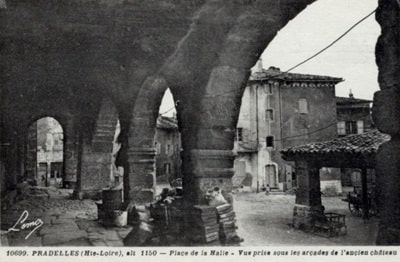 In the ancient village of Pradelles, a medieval jewel stands proudly: the Rochely Tower. Once, this place was a vital crossroads, uniting Gévaudan and Velay. In the 14th century, while the Wars of Religion raged, this tower, erected by the noble family of Rochelix, served as an advanced stronghold, protecting the town from marauders and invasions. Today, although the arrow slits and loopholes have disappeared, their shadows still haunt the walls, silent witnesses of a tumultuous past.
In the ancient village of Pradelles, a medieval jewel stands proudly: the Rochely Tower. Once, this place was a vital crossroads, uniting Gévaudan and Velay. In the 14th century, while the Wars of Religion raged, this tower, erected by the noble family of Rochelix, served as an advanced stronghold, protecting the town from marauders and invasions. Today, although the arrow slits and loopholes have disappeared, their shadows still haunt the walls, silent witnesses of a tumultuous past.
The Besset Gate, once the second rampart after the main gate of La Halle, stood as a stoic guardian of Pradelles. Built in the early 14th century, it embodied the resilience of a town rising from the ashes of the Hundred Years' War. Today, stripped of its defenses, it opens onto two pointed arches, remnants of a time when the portcullis fell heavily to protect the inhabitants from external threats.
In the heart of Pradelles, the Maison Frévol rises as a monument to medieval prosperity. Located on the Regordane route, the village flourished, surrounded by its protective walls. In the 16th century, it became a crucial military and religious center. The houses on the Halle square, with their arcaded galleries, recount the history of the influential families who lived there, weaving the social and economic fabric of the town.
The Melon Fountain, crowned with a melon sculpture, is a discreet homage to the Way of St. James. Pilgrims, en route to Saint-Gilles, would stop here, in what was the beating heart of Pradelles. The steps leading to the fountain evoke the emblematic shell of the pilgrim, and the water that flowed there was the vital blood of the village, a meeting place and a space for sharing for all its inhabitants.
Former holiday hotel with a garden along the Allier, L'Etoile Guest House is located in La Bastide-Puylaurent between Lozere, Ardeche, and the Cevennes in the mountains of Southern France. At the crossroads of GR®7, GR®70 Stevenson Path, GR®72, GR®700 Regordane Way, GR®470 Allier River springs and gorges, GRP® Cevenol, Ardechoise Mountains, Margeride. Numerous loop trails for hiking and one-day biking excursions. Ideal for a relaxing and hiking getaway.
Copyright©etoile.fr